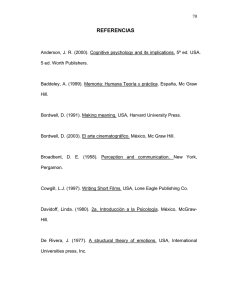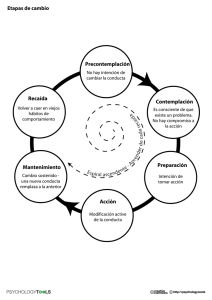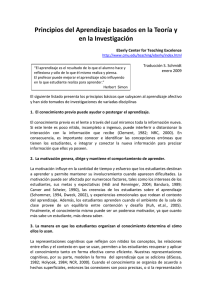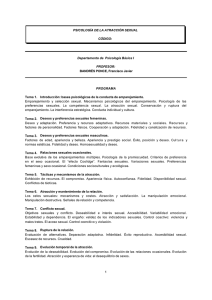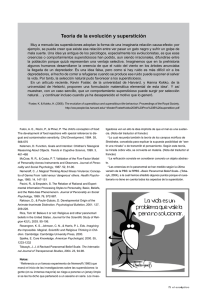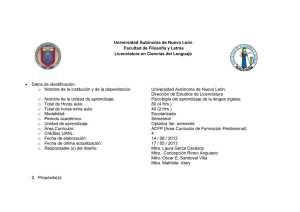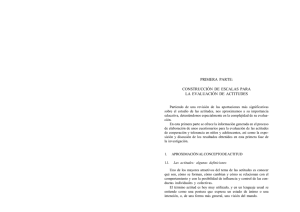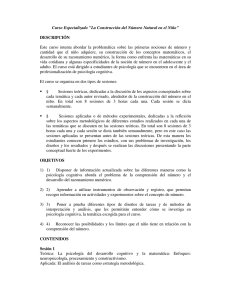bibliografía - Universidad de Granada
Anuncio
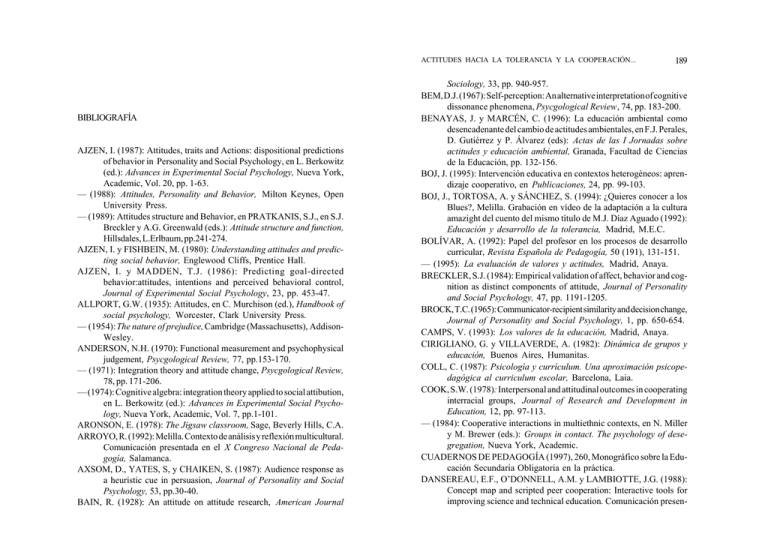
ACTITUDES HACIA LA TOLERANCIA Y LA COOPERACIÓN... BIBLIOGRAFÍA AJZEN, I. (1987): Attitudes, traits and Actions: dispositional predictions of behavior in Personality and Social Psychology, en L. Berkowitz (ed.): Advances in Experimental Social Psychology, Nueva York, Academic, Vol. 20, pp. 1-63. — (1988): Attitudes, Personality and Behavior, Milton Keynes, Open University Press. — (1989): Attitudes structure and Behavior, en PRATKANIS, S.J., en S.J. Breckler y A.G. Greenwald (eds.): Attitude structure and function, Hillsdales, L.Erlbaum, pp.241-274. AJZEN, I. y FISHBEIN, M. (1980): Understanding attitudes and predicting social behavior, Englewood Cliffs, Prentice Hall. AJZEN, I. y MADDEN, T.J. (1986): Predicting goal-directed behavior:attitudes, intentions and perceived behavioral control, Journal of Experimental Social Psychology, 23, pp. 453-47. ALLPORT, G.W. (1935): Attitudes, en C. Murchison (ed.), Handbook of social psychology, Worcester, Clark University Press. — (1954): The nature of prejudice, Cambridge (Massachusetts), AddisonWesley. ANDERSON, N.H. (1970): Functional measurement and psychophysical judgement, Psycgological Review, 77, pp.153-170. — (1971): Integration theory and attitude change, Psycgological Review, 78, pp. 171-206. — (1974): Cognitive algebra: integration theory applied to social attibution, en L. Berkowitz (ed.): Advances in Experimental Social Psychology, Nueva York, Academic, Vol. 7, pp.1-101. ARONSON, E. (1978): The Jigsaw classroom, Sage, Beverly Hills, C.A. ARROYO, R. (1992): Melilla. Contexto de análisis y reflexión multicultural. Comunicación presentada en el X Congreso Nacional de Pedagogía, Salamanca. AXSOM, D., YATES, S, y CHAIKEN, S. (1987): Audience response as a heuristic cue in persuasion, Journal of Personality and Social Psychology, 53, pp.30-40. BAIN, R. (1928): An attitude on attitude research, American Journal 189 Sociology, 33, pp. 940-957. BEM, D.J. (1967): Self-perception: An alternative interpretation of cognitive dissonance phenomena, Psycgological Review, 74, pp. 183-200. BENAYAS, J. y MARCÉN, C. (1996): La educación ambiental como desencadenante del cambio de actitudes ambientales, en F.J. Perales, D. Gutiérrez y P. Álvarez (eds): Actas de las I Jornadas sobre actitudes y educación ambiental, Granada, Facultad de Ciencias de la Educación, pp. 132-156. BOJ, J. (1995): Intervención educativa en contextos heterogéneos: aprendizaje cooperativo, en Publicaciones, 24, pp. 99-103. BOJ, J., TORTOSA, A. y SÁNCHEZ, S. (1994): ¿Quieres conocer a los Blues?, Melilla. Grabación en vídeo de la adaptación a la cultura amazight del cuento del mismo título de M.J. Díaz Aguado (1992): Educación y desarrollo de la tolerancia, Madrid, M.E.C. BOLÍVAR, A. (1992): Papel del profesor en los procesos de desarrollo curricular, Revista Española de Pedagogía, 50 (191), 131-151. — (1995): La evaluación de valores y actitudes, Madrid, Anaya. BRECKLER, S.J. (1984): Empirical validation of affect, behavior and cognition as distinct components of attitude, Journal of Personality and Social Psychology, 47, pp. 1191-1205. BROCK, T.C. (1965): Communicator-recipient similarity and decision change, Journal of Personality and Social Psychology, 1, pp. 650-654. CAMPS, V. (1993): Los valores de la educación, Madrid, Anaya. CIRIGLIANO, G. y VILLAVERDE, A. (1982): Dinámica de grupos y educación, Buenos Aires, Humanitas. COLL, C. (1987): Psicología y currículum. Una aproximación psicopedagógica al curriculum escolar, Barcelona, Laia. COOK, S.W. (1978): Interpersonal and attitudinal outcomes in cooperating interracial groups, Journal of Research and Development in Education, 12, pp. 97-113. — (1984): Cooperative interactions in multiethnic contexts, en N. Miller y M. Brewer (eds.): Groups in contact. The psychology of desegregation, Nueva York, Academic. CUADERNOS DE PEDAGOGÍA (1997), 260, Monográfico sobre la Educación Secundaria Obligatoria en la práctica. DANSEREAU, E.F., O’DONNELL, A.M. y LAMBIOTTE, J.G. (1988): Concept map and scripted peer cooperation: Interactive tools for improving science and technical education. Comunicación presen- 190 SEBASTIÁN SÁNCHEZ y Mª CARMEN MESA tada al Annual Meeting of the American Educational Research Association, Nueva Orleans, L.A. DEVRIES, D. y SLAVIN, R.E. (1978): Team-Games-Tournament (TGT): Review of then classroom experiments. Journal of Research and Development in Education, 12, pp. 28-38. DÍAZ-AGUADO, M.J. (1986): El papel de la interacción entre iguales en la adaptación escolar y el desarrollo social, Madrid, Servicio de Publicaciones del MEC. — (1988): La interacción entre compañeros. Un modelo de intervención psicoeducativa, Madrid, CIDE. — (1992): Educación y desarrollo de la tolerancia, 4 volúmenes y un vídeo, Madrid, MEC. — (1996): Escuela y tolerancia, Madrid, Pirámide. DÍAZ-AGUADO, M.J. (Dir.) (1996): Programas de prevención del racismo y la violencia en los jóvenes, Madrid, vídeo editado recogiendo diferentes imágenes e información. DÍAZ-AGUADO, M.J. y BARAJA, A. (1993): Interacción educativa y desventaja sociocultural. Un modelo de intervención para favorecer la adaptación escolar en contextos interétnicos, Madrid, CIDE. DOLZ, M.D. y PÉREZ, P. (1994): El trabajo en el aula, Cuadernos de Pedagogía, 227, pp. 19-21. DOOB, L. (1947): The behavior of attitudes, Psychology Review, 54, pp. 135-156. EAGLY, A.H. y CHAIKEN, S. (1984): Cognitive theories of persuasion, en L. Berkowitz (ed.):Advances in experimental social psychology, Nueva York, Academic, Vol.17, pp. 267-359. ECHEBARRÍA, A. (ed.) (1991):Psicología Social Sociocognitiva, Bilbao, Desclée de Brouwer. ECHEBARRíA, A., PAEZ, D., MARTINEZ, B. y VALENCIA, J.F. (1987): Autoconciencia, conducta y emoción, en Boletín de Psicología, 15, pp. 84-114. EISER, J.R. (1989): Psicología Social. Madrid, Pirámide. ESCAMEZ, J. y ORTEGA, P. (1986): La enseñanza de actitudes y valores, Valencia, Nau Llibres. ETXEBERRÍA, J. JOARISTI, L. y LIZASOAÍN, L. (1990):Programación y análisis estadísticos básicos con Spss-pc+, Madrid, Paraninfo. FAZIO, R.H. (1986): How do attitudes guide behavior?, en R.M Sorrentino ACTITUDES HACIA LA TOLERANCIA Y LA COOPERACIÓN... 191 y E.T. Higgins (eds.): Handbook of motivation and cognition, Nueva York, Wiley. — (1989): On the power and functionality of attitudes: The role of accessibility, en S.R. Pratkanis, S.J. Breckler y Greenwald, A.G. (eds.): Attitude structure and function, Hillsdale, L. Erlbaum, pp. 153-179. FENIGSTEIN, A., SCHEIER, M.F. y BUSS, A.H. (1975): Public and private self-consciousness: Assessment and theory, Journal of Consulting and Clinical Psychology, vol. 43, 4, pp. 522-527. FESTINGER, L. (1957): A theory cognitive dissonance,Stanford University Press. FESTINGER, L. y CARLSMITH, J. (1959): Cognitive consequences of forced compliance, Journal of Abnormal and Social Psychology, 58, pp. 203-210. FISHBEIN, M.(ed.) (1967): Reandings in Atittude Theory and Measurement, Nueva York, Wiley. FISHBEIN, M. (1980): A theory of reasoned actions: some applications and implications, en M. Page (ed.): Beliefs, attitudes and values, Lincoln, University Nebraska Press. FISHBEIN, M. y AJZEN, I. (1975):Belief, attitude, intention and behavior: An introduction to theory and research, Reading, Addison Wesley. — (1980): Predicting and understanding consumer behavior: Attitudebehavior correspondence, en I. Ajzen y M. Fishbein (eds.), Understanding Attitudes and Predicting Social Behavior, Englewood Cliffs, NJ: Prentice Hall. GARZÓN, A. y GARCÉS, J. (1989): Hacia una nueva conceptualización del valor, en A. Rodríguez y J. Seoane (coords.): Creencias, actitudes y valores, vol. 7 del Tratado de Psicología general, dirigido por J. Mayor y J.L. Pinillos, Madrid, Alhambra, cap. 7 (pp. 365-407). GARZÓN VALDÉS, E. (1997): La relevancia moral de la diversidad cultural, Claves de Razón práctica, 74. GÓMEZ, L. y CANTO, J.M. (coords.) (1995): Psicología Social, Madrid, Eudema. GOÑI, A. (1992): La educación social. Un reto para la escuela, Barcelona, Grao. GREENWALD, A.G., (1968): Cognitive learning, cognitive response to persuasion and attitude change, en A. Grenwald y T.C. Brook y T.M. Ostrom (eds.): Psychological foundations of attitudes. Nueva York, Academic, pp. 147-170. 192 SEBASTIÁN SÁNCHEZ y Mª CARMEN MESA GUTTMAN, L. (1944): A basis for scaling qualitive data, American Psychology Review, 9, pp. 139-150. HEIDER, F. (1944): Social perception and phenomenal causality, Psychology Review, 51, pp. 358-374. HOVLAND, C.I., LUMSDAINE, A.A. y SHEFFIELD, F.D. (1949): Experiment on mass communication, Princenton, University Press. JOHNSON, D.W., JOHNSON, R.T. y HOLUBEC, E. (1986): Circles of learning: Cooperation in the classroom, Edina, M. N., Interaction Book Company. KAGAN S. y KAGAN, M. (1992): Advanced cooperative learning: Playing with elements, San Juan de Capistrano, C. A., Kagan Cooperative Learning. KAGAN, S. y KAGAN, M. (1994): The estructural approach: Six keys to cooperative learning, en S. Sharan (ed.): Handbook of cooperative learning methods, Westport, C.T., Greenwood Press, pp. 115-133. KATZ, D. y STOTTLAND, E.A. (1959): A preliminary statement to a theory of attitude structure and change, en S. Koch (ed.), III, pp. 423-475, citado en J. Mayor y J.L. Pinillos (1989): Creencias, actitudes y valores, Madrid, Alhambra. KRECH, D. y CRUTCHFIELD, R.S. (1948):Theory and problems in social psychology, Nueva York, McGraw-Hill. LAPIERE, R. (1934): Attitudes versus Actions, Social Forces, 13, pp. 230237. LARA ORTEGA, F. (1995): Interacción entre iguales y aprendizaje cooperativo, en J. Beltrán Llera y J. A. Bueno: Psicología de la educación, Barcelona, Marcombo, pp. 437-455. LEY ORGÁNICA 1/1990 de 3 de octubre, de Ordenación General del Sistema Educativo. (B.O.E. de 4 octubre), pp. 28927-28942. LIKERT, R. (1932): A technique for the measurement of attitudes,Archives of Psychology, 140, pp.44-45. MARKUS, H., y ZANJOC, R.B. (1985): The cognitive perspective in social psychology, en A. Lindzey y E. Aronson (eds.): Handbook of Social Psychology, vol. 1, Nueva York, Randow House, pp. 137230. McGUIRE, W.J. (1968): Personality and susceptibility to social influence, E.F. Borgatta y W.W. Lambert: Handbook of personality theory and research, Chicago, Rand McNally. ACTITUDES HACIA LA TOLERANCIA Y LA COOPERACIÓN... 193 — (1969): The nature of attitudes and attitude change, en A. Lindzey y E. Aronson (eds.): Handbook of social psychology, Reading, Adison-Wesley. — (1985): Attitude and attitude change, en A. Lindzey y E. Aronson (eds.): Handbook of Social Psychology, Nueva York, Randow House. MINISTERIO DE EDUCACIÓN Y CIENCIA (1992): Materiales para la Reforma (Cajas Rojas). Educación Secundaria Obligatoria. Madrid, Servicio de Publicaciones. — (1993): Temas transversales y desarrollo curricular. Madrid, Servicio de Publicaciones. MESA, M.C. y SÁNCHEZ, S. (1996): Educación y situaciones bilingües en contextos multiculturales. Estudio de un caso: Melilla. Granada y Madrid, Laboratorio de Estudios Interculturales y CIDE. MILLER, N. y BREWER, M (1984): Groups in contact. The psychology of desegregation, Nueva York, Academic. MORALES, J.F. y otros (1995): Psicología Social, Madrid, McGraw-Hill. MORENO, M. (1993): Los temas transversales: una enseñanza mirando hacia adelante, en M.D. Busquets y otros: Los temas transversales. Claves de la formación integral. Madrid, Santillana, pp. 10-43. MUÑIZ, J. (1992): Teoría clásica de los tests, Madrid, Pirámide. O’DONNELL, A.M. y DANSEREAU, D.F. (1992): Scripted cooperation in student dyads: A method for analyzing and enhancing academic learning and performance, en R. Hertz-Lazarowitz y N. Miller (eds.): Interactions in cooperative groups: the theorical anatomy of group learning, New York, Cambridge University Press, pp. 120141. OSGOOD, C. y TANNENBAUM, P. (1955): The principle of congruity in the prediction of attitude change, Psychology Review, 62, pp. 4255. OVEJERO, A. (1990): El aprendizaje cooperativo. Una alternativa eficaz a la enseñanza tradicional. Barcelona, PPU. PARDO, A. y SAN MARTÍN, R. (1994): Análisis de datos en Psicología II, Madrid, Pirámide. PETTY R.E. y BROCK, T.C., (1981): Thought disruption and persuasion: Assessing the validity of attitude change experiments, en R.E. Petty, T.M. Ostrom y C. Brock (eds.): Cognitive responses in persuasion, Hillsdale, L. Erlbaund, pp. 55-79. 194 SEBASTIÁN SÁNCHEZ y Mª CARMEN MESA PETTY, R.E. Y CACIOPPO, J. (1981): Attitudes and persuasion: classic and contemporary approaches, Dubuque, Iowa, W.C. Brown. — (1986): Communication and persuasion. Central and Pheriperical Routs to attitude change. Nueva York, Springer-Verlag. PUIG, J.M. Y MARTÍN, M. (1989): Educación moral y democracia, Barcelona, Laertes. REALES DECRETOS 1333/1991, 1344/1991 y 1345/1991, de 6 de septiembre, por los que se establecen, respectivamente, los currículos de la Educación Infantil, la Educación Primaria y la Educación Secundaria Obligatoria. REYZÁBAL, M.V. y SANZ, I.A. (1995): Los ejes transversales. Aprendizajes para la vida. Madrid, Escuela Española. ROKEACH, M. (1968): Actitudes, en Enciclopedia Internacional de Ciencias Sociales, vol. 1. Madrid, Aguilar. ROSENBERG, M. Y HOVLAND, C.I. y colbs. (1960):Attitude organization and change, N. Haven, Yale University Press. ROTHBART, M. y JOHN, O. (1985): Social categorization and behavioral episodes: A cognitive analysis of the effects of intergroup contact, Journal of Social Issues, 41, pp. 81-104. SABATER, J.M. (1989): Sobre el concepto de actitud, Anales de Pedagogía, (Universidad de Murcia), 7, pp. 159-187. SAN MARTÍN, R. y PARDO, A. (1989): Psicoestadística. Contrastes paramétricos y no paramétricos. Madrid, Pirámide. SÁNCHEZ, S. (1996): La educación intercultural como estrategia de reducción-eliminación del racismo, en F. Jiménez Bautista, A. Sánchez Sánchez y T. Valenzuela (eds.): Ciudades contra el Racismo “Granada, ciudad integradora”. Granada, Instituto Municipal de Formación y Empleo, pp. 89-99. SÁNCHEZ, S. y JIMÉNEZ BAUTISTA, F. (1997): Formación de actitudes frente al racismo. ¿Es posible?, en JIMÉNEZ BAUTISTA, F. y SÁNCHEZ, S. (Eds.): Granada, ciudad intercultural e integradora. Materiales didácticos para un debate intercultural: Granada y su juventud. Granada, IMFE e Instituto de la Paz y los Conflictos de la Universidad de Granada, pp. 329-355. SARNOFF, I. (1960): Reaction formation and cynism,Journal Personality Psychology. Nueva York, Chandler. SAVATER, F. (1995): Los requisitos de la tolerancia, Diario El País, 22 de abril, p. 13. ACTITUDES HACIA LA TOLERANCIA Y LA COOPERACIÓN... 195 SELMAN, R. (1980): The growth of interpersonal understanding. Nueva York, Academic Press. SERRANO, J.M. (1996): Aprendizaje cooperativo, en J. Beltrán Llera y C. Genovard (eds.): Psicología de la Instrucción I: Variables y procesos básicos. Madrid, Síntesis, pp. 217-244. SERRANO, J.M. y CALVO, M.T. (1994): Aprendizaje cooperativo. Técnicas y análisis dimensional. Murcia, Fundación cultural de Caja Murcia. SHARAN, S., HARE, P., WEBB, C. y HERTZ-LAZAROWITZ, R.A. (1980): Cooperation in education. Provo, U.T., Brigham Young University Press. SHARAN, Y. y SHARAN, S. (1994): Group investigation in the cooperative classroom, en S. Sharan (ed.): Handbook of cooperative learning methods. Westport, C.T., Greenwood Press, pp. 97-114. SLAVIN, R.E. (1978): Student Teams and Achievement Divisions, Journal of Research and Development in Education, 12, pp. 39-49. — (1994): Student Teams and Achievement Divisions, en S. Sharan (ed.): Handbook of cooperative learning methods, Westport, C.T., Greenwood Press, pp. 3-19. SMITH, M.B.; BRUNER, J.S. y WHITE, R.W. (1956): Opinions and personality. Nueva York, Wiley. STAATS, A.W., y STAATS,C.K. (1958): Attitudes established by classical condititioning, Journal of Anormal and Social Psychology, 57, pp. 37-40. TESDECHI, J. (1981) (ed): Impression management theory and social psychological research, Nueva York, Academic Press. THOMAS, W. y ZNANIECKI, F. (1918): The polish peasant in Europe and America, Vol.1, Univ. Chicago Press. THURSTHONE, L. Y CHAVE, E. (1929): The measurement of attitudes. Chicago University Press. TRENHOLM, M.S., (1989): Persuasion and social influence. Englewood Cliffs, Prentice Hall. TRIANDIS, H.C. (1974): Actitudes y cambio de actitudes. Barcelona, Toray. WICKER, A. (1969): Attitudes versus actions: The relationship of verbal and overt behavioral responses to attitudes objects, Journal Social Issues, 25, pp. 41-78. 196 SEBASTIÁN SÁNCHEZ y Mª CARMEN MESA WOODS, P. y HAMMERSLY, M. (comps.) (1995):Género, cultura y etnia en la escuela. Informes etnográficos. Madrid y Barcelona, MEC y Paidós. YUS, R. (1994): ¿Educar o enseñar?: el reto de las transversales, Aula de Innovación Educativa, 33, p. 71. — (1996): Temas transversales. Hacia una nueva escuela. Barcelona, Graó. ZANNA, M.P. Y FAZIO, R.H. (1982): The attitude behavior relation: moving toward a third generation of research, en M.P. Zanna, E.T. Higgins y C.P. Herman (eds.): Consistency in social behavior. Hillsdale, Erlbaum, pp. 283-301. ZANNA, M.P. Y REMPEL, J.K. (1986): Attitudes: A new look at an old concept, en D. Bartal y A.W. Kruglanski (eds.): Social knowledge. Nueva York, Cambridge University Press. ZIMBARDO, P.G. y LEIPPE, M.R. (1991): The psychology of attitude change and social influence. Nueva York, McGraw-Hill. ACTITUDES HACIA LA TOLERANCIA Y LA COOPERACIÓN... 197
